|
|
|
|
 |
|||||||
| HISTORY | ||||||||
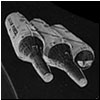 |
On October 12, 1964, during a meeting of leading specialists of the OKB-52 design bureau, based in Reutov near Moscow, Chief Designer Vladimir Chelomei announced the start of the Orbital Piloted Station project, OPS, code-named Almaz or "Diamond." The Soviet government saw the Almaz as a response to the US Manned Orbiting Laboratory, MOL. |
|||||||
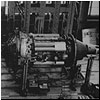 |
Development of the Almaz space station For most of the 1960s, the Almaz program remained on the backburner, as the Soviet space industry focused its efforts on the Moon race with the United States. Technical problems and political intrigue also plagued Almaz. But eventually, the Soviet military gave Vladimir Chelomei the green light to bring the Almaz project to the launch pad. |
|||||||
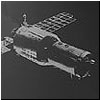 |
OPS-1 (Salyut-2)
The first Almaz station, OPS-1, made it to Baikonur in the midst of harsh winter of 1973. After several months of preparation, it blasted off into orbit on April 3, 1973. The first crew was preparing to fly to the station, however, a mysterious accident just days after the launch left OPS-1 disabled and depressurized. |
|||||||
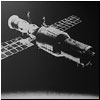 |
NEW, May 27: Kosmos-656: First test of a crew transport for Almaz (INSIDER CONTENT) On May 27, 1974, a classified mission, designated Kosmos-656, flight-tested a modified Soyuz spacecraft intended for carrying cosmonauts to the Almaz military orbital lab. |
|||||||
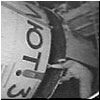 |
The OPS-2, announced as Salyut-3, was launched on June 25, 1974. The crew of the Soyuz-14 spacecraft spent 15 days onboard the station in July 1974. The second expedition launched toward OPS-2 in August 1974, failed to reach the station. Salyut-3 was deorbited in January 1975. |
|||||||
 |
NEW, July 3: Soyuz-14: The USSR launches first military station crew On July 3, 1974, the Soyuz-14 mission carried what was announced as an expedition to the newly launched Salyut-3 space station. In fact, it was a specialized military team heading to the Almaz OPS-2 orbital observation outpost publicly camouflaged behind a civilian space station program. |
|||||||
NEW, Aug. 26: Soyuz-15: The Soviet military crew fails to reach its orbital post On Aug. 26, 1974, the USSR launched the second expedition to the Almaz OPS-2 military space station, operating in Earth's orbit under a cover name Salyut-3. However, commander Gennady Sarafanov and flight engineer Lev Demin failed to dock their Soyuz-15 spacecraft to the outpost, narrowly avoiding a high-speed collision. The crew then urgently headed home after just two days in orbit. |
||||||||
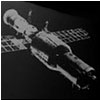 |
The OPS-3, announced after the launch as Salyut-5, entered orbit on June 22, 1976. It was visited by two crews in the summer of 1976 and winter of 1977. Between two successful expeditions, one crew failed to reach the station and had to conduct an urgent landing, resulted in the first ever splashdown of the Soviet spacecraft. |
|||||||
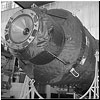 |
The next Almaz station, OPS-4, promised a number of radical upgrades in the project. However, from the beginning of 1978, the funding for the Almaz project has started disappearing, dragging the construction of OPS-4 behind schedule. The station was ultimately grounded and has become a rare artifact of the Almaz project. |
|||||||
| Scientific Almaz-N
During 1974-1976, NPO Mash studied an unmanned version of the Almaz for astronomical and remote-sensing research under designation Almaz-N, where "N" likely stood for "nauka" or "science." The work grew out of an Order No. 170 by the Ministry of General Machine building, MOM, issued on June 15, 1972. |
||||||||
| Robotic
Almaz
On June 28, 1978, the Soviet government officially killed the development of manned orbital stations at Chelomei's TsKBM design bureau. The Almaz station was downgraded to a heavy radar-carrying reconnaissance satellite, which could be visited by servicing crews and later to a fully unmanned spacecraft. |
||||||||
|
The Almaz spacecraft with a manufacturing ("zavodskoi") number 0205-02 was largely completed by the time, the project was stopped. The spacecraft was apparently build for manned missions and later refurbished for autonomous flight. |
||||||||
|
Only hull of the spacecraft with the manufacturing ("zavodskoi") number 0206-02 was ready by the time the program was discontinued. The design of the hull indicated that at least originally it was intended for manned missions. |
||||||||
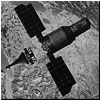 |
Initial hopes to commercialize the Almaz space station during the 1990s, relied on its capabilities to take photographic and radar imagery of the Earth surface. A US-based marketing office, which would offer on-demand imagery to commercial clients, had been set up, however the project had never taken off. |
|||||||
| TECHNOLOGY | ||||||||
 |
As proposed in 1964, the Almaz space station, also designated 11F71 or 11F71B, was designed to have a rotating crew of three people and an operational life of one or two years. The habitable volume of the Almaz station was divided into following main areas:
|
|||||||
 |
TKS
spacecraft
The TKS was designed to be launched by the Proton rocket, to carry a three-man crew, up to eight small film return capsules and other supplies for the Almaz station. The TKS was equipped with the I11F77 propulsion system and eight externally attached cylindrical propellant tanks. |
|||||||